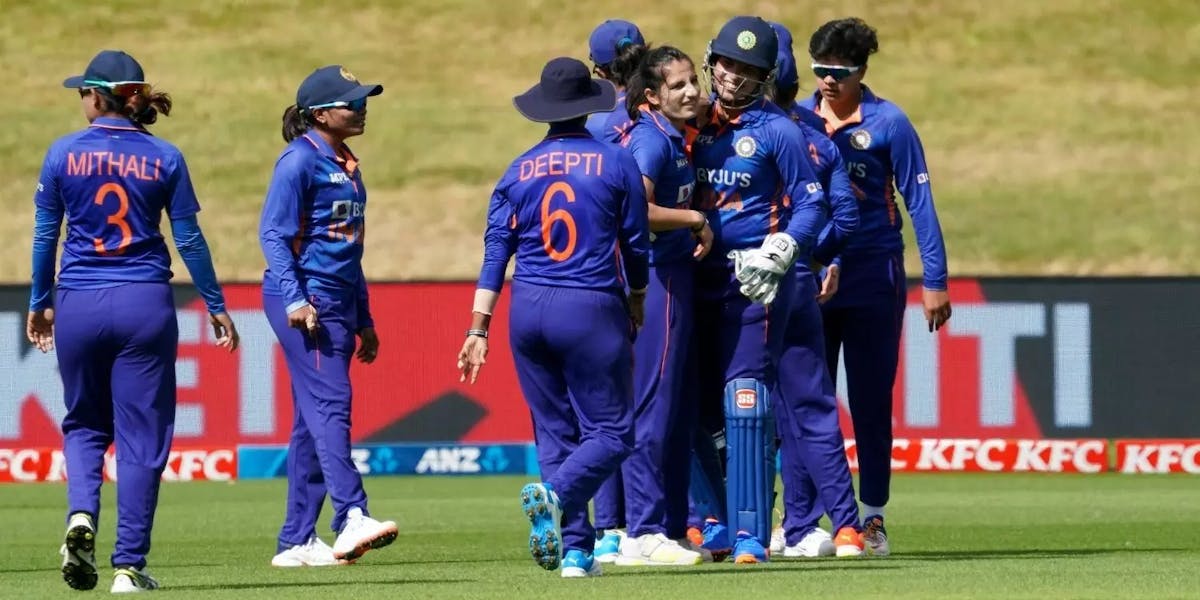
India-W and a Gaze at Glory!

It’s been around 44 years since India Women made their WODI debut and played their first ever World Cup. They’ve been to semi-finals and even finals twice, but couldn’t get hands on the ultimate prize. This includes a heart-breaking 9-run loss against England at the iconic Lord’s stage in the final of the previous edition, credits some bowling brilliance from England. ‘Can they go that one step further and clinch the title this year?’ – is what every Indian fan is keen to know.
As a matter of fact, this is also the last time we get to see the Indian veterans, Mithali Raj and Jhulan Goswami, undoubtedly legends of the game, give a shot at glory. They’ve been carrying the game on their shoulders for the nation over two decades, for which these two deserve a fitting finish with the silverware. India will be keen to give their senior pros a satisfying farewell.
But it is not going to be an easy task, especially given the current forms of teams. Australia enters the World Cup as firm favourites as always, being the most consistent team of all the eight competing teams, having lost just two of their WODI matches since the end of the 2017 World Cup. South Africa are in good form and proved it in the recently concluded series against West Indies. Hosts New Zealand too have come back to winning ways after some terrible years of WODI. Defending champions England may have gone down to Australia in the Ashes, but they are a strong team.
Hence, if India want to get into the top-four, they will have to give their best and work their hearts out to break in. India’s current form is a matter of concern, given they enter with consecutive series defeats, with the latest one coming against hosts New Zealand. This can be partly related to the pandemic, as the Indian Women lost only one bilateral WODI series (against Aus-W) after the 2017 World Cup, before waves of COVID-19 began to hit. After that, India couldn’t have game time for more than a year. When the rusty India came back together, they found it tough to get going. They played four bilateral series and lost all four of them, managing a solitary win in each series, against each of the SENA country.
The current team has a mix of promising youth and reliable experience. But, the biggest surprises from squad announcement came in the form of the exclusion of star players like Jemimah Rodrigues, Punam Raut and Shikha Pandey. Fans were left quite surprised by the decision. The squad has too many players with less than 10 WODI match experience, but this is the team they built for the showpiece event.
The recent series against New Zealand showed promise and consistency in the batting unit, with various batters rising to the occasion, but the bowling let the team down. Apart from Jhulan, who is still grinding at 39, the bowling unit didn’t show any threat.
As far as the batting unit is concerned, Shafali Verma’s series of lacklustre performances doesn’t help. Mandhana is in good form, she also won the Rachael Heyhoe Flint Trophy for ICC Women’s Cricketer of the Year 2021. Yastika Bhatia promises with glimpses of her useful capability, while Mithali is as consistent as ever. There was criticism on Raj’s strike rate, but she had been finding ways to strike at a better rate and she was able to bring her strike rate up in the NZ-W series. Richa Ghosh, an ever-developing wicket-keeper, is a proven player with big hitting abilities too. The best news is that Harmanpreet Kaur has found her rhythm again, scoring a half century in the last match of the NZ series and a century in the warm-up match against South Africa.
Deepti Sharma is a reliable all-rounder. Jhulan is leading the bowling unit as she always does, but lacks support. This is where the headache begins. She is consistent with good performances, but without her, the bowling doesn’t look as strong as it should be. The bowlers simply couldn’t extract venom to threaten the batters and gave away easy runs against NZ-W. Somehow, they managed to find out their flaws and delivered in the only win in the series, and also in the warm-up games. Fielding is another concern for this Indian team. In almost all of the matches they lost, they were sloppy in the field. Even in the games they won, they were still sloppy, but less sloppy than the opponent. Going into the big event, the team has to get better on field with every game they play.
These are challenges that are obvious to the eyes of any fan, but there is yet another challenge only the players can feel – handling mental pressure. India Women had been asking for a sports psychologist since the end of the 2016 ICC Women’s World T20. Later, they went on to lose pressure matches that includes two ICC finals and a semi-final. But finally, this year BCCI decided to send a sports psychologist Dr. Mugdha Bavare with the team. And it is already reaping rewards. It is because of the psychologist; Kaur could find her form again. She acknowledged that Mugdha played a very big role when she was not getting runs, and she helped Kaur from ‘going into her shell’.
The team is also back to winning ways, with back-to-back victories in the warm-up games. The one against South Africa was quite the thriller, as it could have gone either way, with India winning by a slender margin of two runs eventually. The last victory against West Indies was a rather comfortable one, winning by a margin of 81 runs with the bowlers finding their rhythm.
These are good signs for the team, and give a great deal of confidence, stepping into the marquee event. Also, India are always capable of giving surprises and upsetting big teams. Hence, we can hope and support the women in blue to script history and bring the cup home this time, for the legends Raj and Goswami. India kickstart their quest on March 6, against arch-rivals Pakistan, against whom they have never lost a WODI. Let us come together and cheer for the nation!
DISCLAIMER: The opinions or views expressed are views of the individual writers and not of the institution. All forms of content published in this website and Student Journalist Council - GCT's social media handles are strictly properties of Student Journalist Council - GCT and are works of the various teams of the respective academic years.
No article, story or any form of content produced by Student Journalist Council - GCT is meant to be reproduced or distributed, either in parts or whole, without prior permission from Student Journalist Council - GCT for any purposes.



